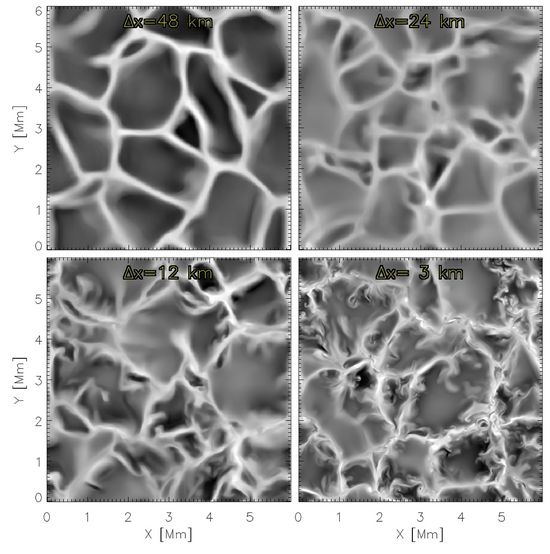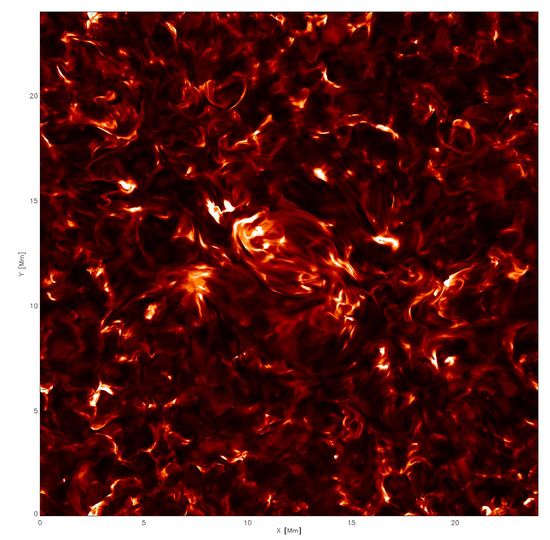ASTROPHYSICS
Physics of the Solar Chromosphere
Principal Investigator:
Mats Carlsson
Affiliation:
Institute of Theoretical Astrophysics, University of Oslo (Norway)
Local Project ID:
pr85wo
HPC Platform used:
SuperMUC of LRZ
Date published:
A simulation project, run on SuperMUC, targets the intrinsic physics of the chromosphere in order to understand its mass and energy budgets and transfer mechanisms. Elucidating these is a principal quest of solar physics, a necessary step towards better space-weather prediction, and of interest to general astrophysics using the Sun as a close-up Rosetta-Stone star and to plasma physics using the Sun and heliosphere as a nearby laboratory. The project aims at a breakthrough in our understanding of the solar chromosphere by developing sophisticated radiation-magnetohydrodynamic simulations.
Introduction:
This project aims at a breakthrough in our understanding of the solar chromosphere by developing sophisticated radiation-magnetohydrodynamic simulations in order to interpret observations from the NASA SMEX mission Interface Region Imaging Spectrograph (IRIS) that was launched in June 2013.
The enigmatic chromosphere is the transition between the solar surface and the eruptive outer solar atmosphere. The chromosphere harbours and constrains the mass and energy loading processes that define the heating of the corona, the acceleration and the composition of the solar wind, and the energetics and triggering of solar outbursts (filament eruptions, flares, coronal mass ejections) that govern near-Earth space weather and affect mankind's technological environment. Small-scale MHD processes play a pivotal role in defining the intricate fine structure and enormous dynamics of the chromosphere, controlling a reservoir of mass and energy much in excess of what is sent up into the corona. This project targets the intrinsic physics of the chromosphere in order to understand its mass and energy budgets and transfer mechanisms. Elucidating these is a principal quest of solar physics, a necessary step towards better space-weather prediction, and of interest to general astrophysics using the Sun as a close-up Rosetta-Stone star and to plasma physics using the Sun and heliosphere as a nearby laboratory.
The research group of the Institute of Theoretical Astrophysics of the University of Oslo under leadership of Mats Carlsson is world-leading in modelling the solar atmosphere as one system; from the convection zone where the motions feed energy into the magnetic field and all the way to the corona where the release of magnetic energy is more or less violent. The computational challenge is both in simplifying the complex physics without loosing the main properties and in treating a large enough volume to encompass the large chromospheric structures with enough resolution to capture the dynamics of the system. The scientists have developed a massively parallel code, called Bifrost, to tackle this challenge. The resulting simulations are very time-consuming but crucial for the understanding of the magnetic outer atmosphere of the Sun.

Figure 1: Solar convection shown as vertical velocity (bright is downflow) at the visible surface showing that increasing the resolution from a grid size of 48 km to 3 km dramatically increases the small scale structure. This has a corresponding effect on how the convective energy can be transported to the outer solar atmosphere. The region shown is about half the diameter of the Earth on the side.
Copyright: Institute of Theoretical Astrophysics, University of Oslo (Norway)Results and Methods:
The models are constructed by using the Bifrost code developed by the team[2]. The core of this code employs a high-order (6th order derivatives, 5th order interpolations) finite difference scheme on a staggered grid that includes high-order artificial viscosity and resistivity ("hyper-diffusion") in order to maintain numerical stability on a grid of finite resolution. These terms are also the source of magnetic and viscous heating. The equations are stepped forward in time using either the third order predictor-corrector procedure of Hyman, modified for variable time steps, or a third order Runga-Kutta scheme. When modelling the solar atmosphere the code is usually set up with periodic boundary conditions in the horizontal directions and characteristic boundaries in the vertical direction, such that the flux of energy and mass into and out of the computational domain can be controlled.
The code is built up in a modular fashion, a number of extra modules are included in order to model the solar atmosphere as realistically as possible: Non-gray, optically thick radiative losses including the effects of scattering in the chromosphere are included, as are non-LTE radiative losses in the chromosphere, optically thin radiative losses in the upper chromosphere and corona and thermal conduction along the magnetic field lines in the corona. A realistic equation of state including partial ionization is included.
Earlier chromospheric simulations performed by the group indicate that the numerical resolution is a critical factor for the quantitative behavior of the simulated chromospheric plasma.

Figure 2: the Sun as viewed in a narrow band filter showing light emitted in the solar chromosphere at a temperature of about 10,000 Kelvin. The synthetic image is derived from numerical simulations that reveal how the Sun’s magnetic field structures its atmosphere on fine scales. The region shown is twice as large as the Earth on the side.
Copyright: Institute of Theoretical Astrophysics, University of Oslo (Norway)In this project the researchers have concentrated on one simulation encompassing a computational volume on the Sun of 24x24x3 Mm3 at much higher resolution (3 km grid-size in a 2048x2048x512 box compared with the 16 km resolution in earlier simulations). This simulation shows that higher numerical resolution allows for more dynamical events in the simulated volume. These more dynamic events are closer to the observed behavior than was the case in previous simulations. The increased resolution allows for more vorticity in the narrow downdrafts in the solar convection leading to both torsional waves entering the upper atmosphere and increased winding of flux-tubes. The simulation used 30 million core hours of computing time. Towards the end of the computing time allocation, the upper atmosphere was added to the box (extending it to 1628 points). The scientists have started on the analysis of the energy balance in the simulation with special focus of the heating of the magnetic chromosphere.
On-going Research / Outlook:
Thanks to the SuperMUC project, the researchers have been able to perform simulations of the solar chromosphere with twice the spatial resolution of their previous highest resolution models. To finish the simulations in a reasonable time (6-8 months), they need to run on more cores than is available to them through their national resources (now maximum 4096 cores). After the analysis of the energy balance in the magnetic chromosphere in the current simulation, the scientists will study the most promising magnetic field configurations from lower resolution simulations with similar high resolution as the SuperMUC simulation. They will also make simulations for larger computational domains including a full solar active region.
Acknowledgements:
This research project was made possible through computing time granted by PRACE (Partnership of Advanced Computing in Europe). HPC system SuperMUC of the Leibniz Supercomputing Centre in Garching near Munich served as computing platform for this simulation project.
References and Links:
[1] http://www.mn.uio.no/astro/english/research/projects/solar-atmospheric-modelling/
[2] Gudiksen B.V, Carlsson M., Hansteen V.H., Hayek W., Leenarts J., Martinez-Sykora J., 2011, Astronomy & Astrophysics, 531, 154
Scientific Contact:
Mats Carlsson
Institute of Theoretical Astrophysics, University of Oslo
Postboks 1029 Blindern, N-0315 Oslo/Norway
e-mail: mats.carlsson [at] astro.uio.no